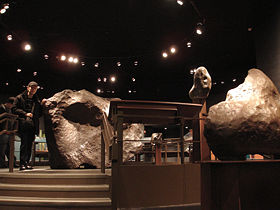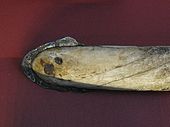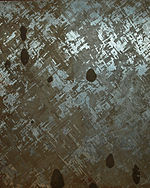- Cape York meteorite
-
Cape York 
This sample is called Ahnighito. It weights 31 t and stands in American Museum of Natural History. Type Iron Group IIIAB Structural classification Octahedrite, medium Composition 7.58% Ni, 19.2 ppm Ga, 36.0 ppm Ge, 5.0 ppm Ir Country Greenland Region Nordgronland Coordinates 76°08′N 64°56′W / 76.133°N 64.933°WCoordinates: 76°08′N 64°56′W / 76.133°N 64.933°W[1] Fall date 10,000 years ago Found date 1894 TKW 58200 kg[1] The Cape York meteorite is named for Cape York, the location of its discovery in Savissivik, Greenland, and is one of the largest iron meteorites in the world.
Contents
History
The meteorite collided with Earth nearly 10,000 years ago. The iron masses were known to Inuit as Ahnighito (the Tent), weighing 31 metric tons; the Woman, weighing 3 metric tons; and the Dog, weighing 400 kg.[2] For centuries, Inuit living near the meteorites used them as a source of metal for tools and harpoons.[3][4]
The first stories of its existence reached scientific circles in 1818. Five expeditions between 1818 and 1883 failed to find the source of the iron. It was located in 1894 by Robert E. Peary, the famous American Navy Arctic explorer, who had enlisted the help of a local Inuit guide - the one who brought him to Saviksoah Island, just off northern Greenland's Cape York in 1894. It took Peary three years to arrange and carry out the loading of the heavy iron meteorites onto ships. It required the building of Greenland's only (small and short) railroad. Perry sold the pieces for $40,000 to the American Museum of Natural History in New York City where they are still on display.
At the American Museum of Natural History today the 3.4 x 2.1 x 1.7 meter Ahnighito is for viewing in the Arthur Ross Hall. The heaviest meteorite that has ever been moved by man, it is so heavy that it was necessary to build its display stand so that its supports reached through directly to the bedrock below the museum.
In 1963, a fourth major piece of the Cape York meteorite was discovered by Vagn F. Buchwald near Agpalilik. The Agpalilik meteorite, also known as the Man, weighs about 20 metric tons, and it is currently on display in the Geological Museum of the University of Copenhagen, Denmark. Other smaller pieces have also been found, such as the 3 tonne Savik I meteorite found in 1911 and the 250 kg Tunorput fragment found in 1984.
Specimens
Each of the most important fragments of Cape York has its own name (listed in order of discovery date):
- Ahnighito (the Tent), 30,900 kg,[5] 1884-1897, Meteorite Island, 76°04'N - 64°58'W
- Woman, 3,000 kg,[5] 1897, Saveruluk, 76°09'N - 64°56'W
- Dog, 400 kg, 1897, Saveruluk, 76°09'N - 64°56'W
- Savik I, 3,400 kg,[5] 1913, Savequarfik, 76°08'N - 64°36'W
- Thule, 48.6 kg, summer 1955, Thule, 76°32'N - 67°33'W[6]
- Savik II, 7.8 kg, 1961, Savequarfik, 76°08'N - 64°36'W
- Agpalilik (the Man), 20,000 kg, 1963, Agpalilik, 76°09'N - 65°10'W[5]
- Tunorput, 250 kg, 1984
Composition and classification
It is an iron meteorite (medium octahedrite) and belongs to the chemical group IIIAB.[1] There are abundant elongated troilite nodules, there is no graphite and has been observed a nitrogen isotopic disequilibrium.[7]
See also
References
- ^ a b c Cape York on the Meteoritical Bulletin Database
- ^ Meteoritical Bulletin, no. 28, Moscow (1963)
- ^ T. A. Rickard (1941). "The Use of Meteoric Iron". The Journal of the Royal Anthropological Institute of Great Britain and Ireland 71 (1/2): 55–66.. doi:10.2307/2844401. JSTOR 2844401.
- ^ Buchwald, V F (1992). "On the Use of Iron by the Eskimos in Greenland". Materials Characterization 29 (2): 139–176. doi:10.1016/1044-5803(92)90112-U.
- ^ a b c d J. Kelly Beatty, Carolyn Collins Petersen, Andrew Chaikin. The new solar system. Cambridge University Press, 1999, ISBN 0521645875
- ^ Meteoritical Bulletin Database: Thule
- ^ Zipfel, J.; Kim, Y.; Marti, K. Nitrogen Isotopic Disequilibrium in the Cape York III A Iron
Bibliography
- Patricia A. M. Huntington. Robert E Peary and the Cape York meteorites
External links
Categories:- Iron meteorites
- Meteorites found in Greenland
- Geology of Greenland
- History of metallurgy
Wikimedia Foundation. 2010.




